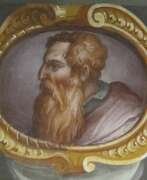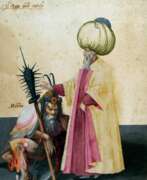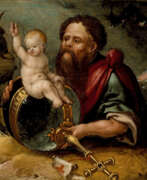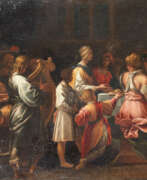Draftsmen 16th century


Albrecht Altdorfer, a notable German painter, engraver, and architect of the Renaissance era, was especially recognized for his contributions to landscape painting. Born around 1480, Altdorfer was a pivotal figure in the Danube School, distinguishing himself with his integration of natural landscapes into biblical and historical narratives.
His works are celebrated for their detailed and expressive landscapes, often serving as backdrops to religious and historical scenes. A hallmark of his style is the emotional intensity and vivid use of colors, which border on expressionistic in his religious scenes, particularly seen in works like the Sebastian Altar in St. Florian's Priory. Altdorfer's painting, "The Battle of Alexander at Issus," stands out for its epic portrayal of Alexander the Great's victory, showcasing Altdorfer's talent in blending historical narrative with dramatic landscape settings.
In addition to his artistic pursuits, Altdorfer was actively involved in the civic life of Regensburg, serving as its mayor in 1528. His legacy in the art world is profound, with his innovative approach to landscape painting influencing the course of European art.
For those interested in delving deeper into Albrecht Altdorfer's oeuvre or staying informed about related exhibitions and auction events, signing up for updates can provide valuable insights and opportunities.


Erhard Altdorfer, a German Early Renaissance printmaker, painter, and architect, is renowned for his contributions to the arts during the 16th century. Born around 1480, Altdorfer's career flourished in Schwerin, where he served as a court painter and architect for the Dukes of Mecklenburg from 1512 until his death in 1561. His journey into the arts likely began under the guidance of his older brother, Albrecht Altdorfer, a prominent figure in the same era.
Altdorfer's early work possibly included collaboration with his brother in Regensburg. By 1512, his talents led him to Schwerin, marking the start of a significant phase in his career. His oeuvre includes various forms, from engravings and woodcuts to paintings and architectural designs. Notable among his works are contributions to the Lübeck Bible, showcasing his skill in woodcut illustrations. Despite the limited number of signed works, his contributions to printmaking and painting hold a place in the history of German Renaissance art. His works, reflecting a blend of influences, including from Lucas Cranach the Elder and Jacopo de' Barbari, demonstrate a unique interpretation of the Renaissance style.
For collectors and experts in art and antiques, understanding Altdorfer's role within the context of the Early Renaissance and his contributions, especially in printmaking and painting, offers a nuanced appreciation of this period. His works, though not as prolifically signed as those of some contemporaries, remain significant for their historical and artistic value. To stay updated on new discoveries or auction events related to Erhard Altdorfer's works, consider signing up for updates to deepen your knowledge and collection of Renaissance art.


Amico Aspertini was an Italian Renaissance painter, draughtsman, and sculptor, considered one of the leading representatives of the Bolognese school of painting.
He was trained in the family workshop and was influenced by the artists of the Ferrara school, Ercole de'Roberti, Lorenzo Costa, and Francesco Francia. He worked as a painter and sculptor, and was also an excellent draughtsman, as evidenced by his many surviving drawings and sketches. Contemporaries marveled at his complex and impulsive character and noted that he worked with both hands simultaneously.
Aspertini painted splendid portraits as well as numerous frescoes and altarpiece paintings in chapels and churches in Italy. Many of his works are eccentric and eclectic, even whimsically fantastical, his complex style anticipating Mannerism.


Pieter Balten or Pieter Custodis was a Flemish Renaissance painter, etcher, draftsman, publisher, and poet. He was a member of the Guild of St. Luke in Antwerp.
Pieter Balten is considered one of the pioneers of realistic depictions of village life, often comic. He also painted religious compositions, landscapes and painted tronies - portraits with comic and even caricatured facial images.
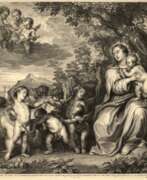

Schelte Adamsz Bolswert was a leading Dutch engraver, noted for his works after Rubens and Van Dyck. Both he and his older brother, Boetius à Bolswert, worked in Amsterdam and Haarlem before settling in Antwerp. For the last five years of his life Boetius worked exclusively on engravings after Rubens. Bolswert's plates were worked entirely with the graver, and he does not seem to have made any use of the drypoint. The freedom which this excellent artist handled the graver, the picturesque roughness of etching, which he could imitate without any other assisting instrument, and the ability he possessed of distinguishing the different masses of colours, have always been admired by the conoisseurs".


Georg Brentel the Younger was a German draftsman, engraver, and author of works on sundials and instrumentation.
He was the son of the cartographer Hans Brentel (1532-1614) and nephew of the armorial artist Georg Brentel the Elder (1525-1610). He always showed an interest in mathematics and astronomy, writing papers on these subjects and making instruments.
Brentel was particularly fond of designing sundials, and wrote several instructions for assembling various types of sundials - round and cubic, cross-shaped and heart-shaped.
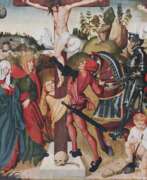

Jörg Breu the Elder of Augsburg, was a painter of the German Danube school. He was the son of a weaver. He journeyed to Austria and created several multi-panel altarpieces there in 1500–02, such as the Melk Abbey altar (1502). He returned to Augsburg in 1502, where he became a master. He travelled to Italy twice, in ca. 1508 and in 1514/15.


Peter Candid was a Flemish painter, tapestry designer, draughtsman and sculptor.
Pieter Candide worked mainly in Italy and Germany. He was an artist at the court of the Medici in Florence and at the Bavarian court of Duke Wilhelm V and his successor Maximilian I in Munich.
His paintings range from historical paintings, portraits, mythological scenes and allegories. He created large altarpiece images as well as complex decorative designs.
Candide's style was characterised by a combination of Italian and Flemish influences, with a particular emphasis on detailed, realistic depictions of the human form.


Bernardo Castello (or Castelli) was an Italian painter of the late-Mannerist style, active mainly in Genoa and Liguria. He is mainly known as a portrait and historical painter. He was apprenticed under Andrea Semino and Luca Cambiaso, then travelled throughout Italy, meeting other painters and creating his own particular style. During his career he painted many works and was appreciated by famous poets with whom he had friendships. Beside working in Genoa, Castello was employed in Rome and worked also for the Duke of Savoy, Charles Emmanuel I.


Bartolomeo Cesi was an Italian painter and draftsman of the Bolognese School. He made easel paintings as well as frescoes. He is known mainly for his religious paintings but he also painted portraits and mythological scenes.


Cornelis Cort, also known as Cornelio Fiammingo, was a Dutch engraver and draughtsman. He began his career in the Northern Netherlands, but later moved to Venice and lived in Titian's house. Cort produced engravings based on Titian's works and became renowned for his copperplates of various subjects. He traveled back and forth between Italy and the Netherlands, establishing a school in Rome and circulating works of famous artists. Cort's impressive output includes over 150 engravings.


Jacopo da Pontormo, an Italian painter born in 1494, was a pivotal figure in the Mannerist movement, diverging from the High Renaissance's balanced compositions to explore more expressive and emotionally charged art. His work is celebrated for its unusual color palettes, elongated forms, and a unique approach to perspective, all of which contribute to the intensely emotional effect of his paintings.
Operating in Florence, Pontormo's art is distinguished by its vivid expressiveness and dramatic tension, characteristics that set him apart from his contemporaries. His ability to convey deep psychological complexity through his subjects has left a lasting impact on the history of art, making his works highly prized among collectors and scholars alike.
One of his most acclaimed works, the "Deposition from the Cross" in the Capponi Chapel in Florence, exemplifies his innovative approach to composition and color, marking a significant departure from traditional depictions of this biblical scene. This masterpiece, along with others like his portraits and religious paintings, can be found in some of the world's most prestigious museums and galleries.
For art collectors and enthusiasts, Jacopo da Pontormo represents the intriguing complexity of the Mannerist period, offering a window into the evolving artistic landscape of 16th-century Italy. His works not only challenge the viewer's expectations but also invite a deeper exploration of the emotional and spiritual dimensions of painting.
To stay abreast of the latest discoveries, exhibitions, and auctions related to Jacopo da Pontormo's art, we encourage you to sign up for updates. This subscription is your gateway to the refined world of Renaissance and Mannerist art, ensuring you're informed about opportunities to enrich your collection with works by this exceptional artist.


Marten de Vos (or Maarten de Vos, or Maerten de Vos) was a Dutch painter, draughtsman and graphic artist, dean of the Antwerp Guild.
After studying in Rome and Venice, de Vos returned to his native Antwerp in 1558 and became one of the city's leading artists. He created altarpiece images for many of Antwerp's churches. Many of his religious and historical paintings were later engraved, making him known throughout Flanders.
De Vos was also the founder of the Society of Romanists, whose members were famous artists and humanists of the time who appreciated the humanistic culture of Rome.


Angelo Falconetto was a Verona artist, draftsman and engraver who lived in the 16th century.
He has many engravings of landscapes and figures. Some are fully signed, others have a monogram that has been erroneously interpreted as being by the 17th century artist Angelo Falcone.


Odoardo Fialetti was an Italian painter and printmaker who began his training during the late Renaissance, and showed distinct mannerist sensibilities in his mid-career, adopting a much looser and more dynamic style in his later life.
Born in Bologna, he initially apprenticed with Giovanni Battista Cremonini, and after traveling to Rome, he moved to Venice to work in the elderly Tintoretto's studio.
From 1604 to 1612, he is listed as member of the Venetian Fraglia dei Pittori. In Venice, he painted a St Agnes for the church of San Nicolò da Tolentino and scenes from the Life of St Dominic for the sacristy of the Santi Giovanni e Paolo.


Frans Floris de Vriendt the Elder was a Flemish painter and engraver of the 16th century.
The artistic style of Frans Floris was strongly influenced by the Italian Renaissance. He combined elements of Italian mannerism with his own interpretation, creating a distinctive style characterized by attention to detail, vivid colours and dynamic compositions.
Frans Floris was known for his large-scale historical and mythological paintings, which often depicted complex subjects and included many figures. His works demonstrated his ability to create dramatic and evocative scenes, exploring themes of religion, mythology and human emotion.


Jacob Grimmer was a Flemish painter who was active during the Late Renaissance. He specialised in landscapes and genre scenes, often depicting the everyday life of peasants.
His style was strongly influenced by Pieter Bruegel the Elder and the works of Leonardo da Vinci and Raphael.
Grimmer's paintings are characterized by detailed, realistic depictions of nature. His landscapes are characterized by wide expanses and intricate detail.
Jacob Grimmer was known for his ability to capture the nuances of human behaviour, so his genre works depict the lives of peasants with a touch of humour and whimsy.




Joris Hoefnagel or Georg Hoefnagel was a Flemish painter, printmaker, miniaturist, draftsman and merchant. He is noted for his illustrations of natural history subjects, topographical views, illuminations and mythological works. He was one of the last manuscript illuminators and made a major contribution to the development of topographical drawing. His manuscript illuminations and ornamental designs played an important role in the emergence of floral still-life painting as an independent genre in northern Europe at the end of the 16th century. The almost scientific naturalism of his botanical and animal drawings served as a model for a later generation of Netherlandish artists. Through these nature studies he also contributed to the development of natural history and he was thus a founder of proto-scientific inquiry. Hoefnagel was a very versatile artist. He is known for his landscapes, emblems, miniatures, grotesques, topographical drawings, genre scenes, and mythological and allegorical drawings and paintings. Part of Hoefnagel's artistic works was kept by Constantijn Huygens his nephew. These works were seen by Dutch artists and exercised an important influence on the development of Dutch still life and naturalist art.
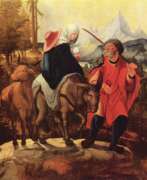

Wolfgang Huber was an Austrian and German painter of the first half of the 16th century, a representative of the Northern Renaissance. He is known as a master of landscape, a representative of the Danubian School, who practiced drawing, painting, architecture and wood engraving.
Huber was famous for his landscape pen drawings, which were valuable works of art at the time. In his later works on religious and portrait subjects, the landscape background also played an important role. He created about thirty paintings and also participated in large projects, including a sketch of the Triumphal Arch of Emperor Maximilian I. His main work is considered to be the altar of St. Anne, created for the church in the Feldkirche.






Iacopo Negretti, best known as Jacopo or Giacomo Palma il Giovane or simply Palma Giovane ("Young Palma"), was an Italian painter from Venice and a notable exponent of the Venetian school. After Tintoretto's death (1594), Palma became Venice's dominant artist perpetuating his style. Outside Venice, he received numerous commissions in the area of Bergamo, then part of the Venetian Domini di Terraferma, and in Central Europe, most prominently from the connoisseur emperor Rudolph II in Prague. Rejecting Mannerism in the 1580s, he embraced a reformist naturalism.[6] He varied the ingeniously synthesised amalgam according to subject matter and patrons' own eclectic and conservative tastes, with "virtuoso skill and a facile intelligence". Palma il Giovane went on to organize his own, large studio which he used to produce a repetitive series of religious and allegorical pictures that can be found throughout the territory of the Venetian Republic.


Luca Penni was an Italian painter, draughtsman and printmaker, nicknamed Romano (Roman).
Luca was the younger brother of Raphael's first assistant, Giovanni Francesco Penni (1488/1496-1528), and must have originally studied under his brother in the environment of Raphael's studio. After Raphael's death, Luca worked in Genoa, then traveled to England, in the service of King Henry VIII, before leaving for France around 1530.
At Fontainebleau, together with French painters, Penni worked on the decoration of the royal palace and became one of the most respected artists there. His work had a marked influence on sixteenth-century French painting and was reproduced by Italian engravers. Penni also produced many designs for engravers including Leon Davent, Etienne Delon and Giorgio Ghisi, as well as for tapestries and stained glass.
The work of the first generation of Italian masters in France, mostly pupils and followers of Raphael, is called the "first school of Fontainebleau", and Luca Penni is a prominent representative of it.


Giulio Cesare Procaccini was an illustrious Italian painter and sculptor of the Baroque period, celebrated for his dynamic and expressive works. Born in Bologna and later moving to Milan, Procaccini's artistry was deeply influenced by the emotional intensity of Mannerism and the vibrant colorism of Venetian painting, signaling the dawn of the Baroque era.
Procaccini's oeuvre includes significant altarpieces such as the "Circumcision" now in the Galleria Estense in Modena, and the "Last Supper" for the Basilica della Santissima Annunziata del Vastato in Genoa. His collaboration with artists like Giovanni Battista Crespi and Pier Francesco Mazzucchelli under the patronage of Cardinal Federico Borromeo highlighted his pivotal role in the Milanese art scene. Moreover, Procaccini's "Ecce Homo" at the Dallas Museum of Art and "The Agony in the Garden" at the Prado Museum in Madrid exemplify his mastery in depicting religious narratives with profound emotion and technical sophistication.
Procaccini's journey through the art world was marked by his initial work as a sculptor, later transitioning to painting, where he left a lasting legacy. Commissioned to paint scenes commemorating the life of Cardinal Carlo Borromeo in Milan Cathedral, his style evolved to exhibit increased clarity and a brighter palette, indicative of his maturation as an artist. His exposure to the works of Rubens and his travels across Italy allowed him to absorb and reinterpret the stylistic elements of Caravaggio, Correggio, and Parmigianino, enriching his own artistic language.
Though not represented in London's National Gallery, Procaccini's paintings grace collections across Europe and beyond, with notable works in the north of England, including "The Mocking of Christ" at Museums Sheffield and "The Raising of the Cross" at the National Galleries of Scotland. These pieces demonstrate his skillful use of color and ability to convey the physical and emotional weight of biblical stories.
For collectors and experts in art and antiques, Giulio Cesare Procaccini represents a fascinating study in the transition from Mannerism to Baroque, embodying the emotional depth and innovative spirit of early 17th-century Italian art. His contributions to the Baroque period remain a testament to his versatility and enduring appeal.
For updates on new discoveries, sales, and auction events related to Giulio Cesare Procaccini, consider signing up for relevant newsletters or alerts. This ensures that enthusiasts and collectors alike are well-informed about the latest opportunities to engage with the magnificent art of Procaccini.


Hans Rottenhammer or Johannes Rottenhammer was a German painter and master of cabinet genre paintings.
After completing his studies as court painter to the Munich royal court, Rottenhammer spent nearly a decade in Venice, and his art bears the influence of Venetian masters such as Tintoretto and Veronese. Rottenhammer opened a studio in the city and attracted patrons and collectors as well as students and followers. In the early 1600s he joined the guild of Venetian artists. It was in Venice that Rottenhammer became famous for his cabinet paintings. These were small works, executed on copper and usually dealing with religious or mythological themes popular at the time.


Andrea Semini was an Italian painter of the late-Renaissance, active mainly in his native Genoa. He was a son and pupil of the painter Antonio Semini. After studying some time under his father, together with his brother Ottavio he went to Rome, and they realized some work in collaboration (frescoes in the Palazzo Marino in Milan). He is well known for his frescoes in several palaces in Genoa, painting for churches and portraits.
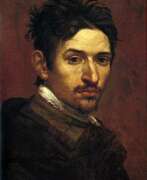

Alessandro Tiarini was an Italian Baroque painter of the Bolognese School. He was the godson of painter Lavinia Fontana and initially apprenticed in Bologna under her father Prospero Fontana, and subsequently with Bartolomeo Cesi. He was not inducted into the Carracci Academy. Forced to flee from Bologna, he moved to Florence, where he painted frescoes, façade decorations, and altarpieces. He painted a series of frescoes for the Brami Chapel in the sanctuary, as well as other works, for the Basilica della Ghiara in Reggio Emilia.


Alessandro Turchi was an Italian painter of the early Baroque, born and active mainly in Verona, and moving late in life to Rome. He also went by the name Alessandro Veronese or the nickname L'Orbetto. His style has been described as soft and Caravaggesque at the same time.


Marten van Cleve the Elder was a Flemish painter and draftsman active in Antwerp between 1551 and 1581. Van Cleve is mainly known for his genre scenes with peasants and landscapes, which show a certain resemblance with the work of Pieter Bruegel the Elder. Marten van Cleve was one of the leading Flemish artists of his generation. His subjects and compositions were an important influence on the work of Pieter Brueghel the Younger and other genre painters of his generation.


Crispijn van de Passe the Elder was a Netherlandish engraver and publisher, renowned for his intricate and evocative engravings that spanned various subjects, including portraits, historical scenes, and mythological tales. His work contributed significantly to the art and culture of the time, capturing the complexities of human emotions and narratives in his prints.
Noteworthy is his engraving of Queen Elizabeth I, which highlights his proficiency in portraiture, illustrating the regal demeanor and significance of the English monarch in 1592. His series on "The Muses," specifically the depiction of Euterpe, showcases his skill in combining engraving with etching to portray the grace and inspiration associated with the muses of classical mythology. Furthermore, his work on "Liber Genesis," particularly "Aftermath of the Flood," demonstrates his ability to convey powerful biblical stories through his artistry.
Crispijn's family, including his children, continued his legacy in engraving, contributing to the family's reputation in the art world. His works are held in prestigious institutions worldwide, such as The Metropolitan Museum of Art in New York and the Rijksmuseum in Amsterdam, underscoring their enduring appeal and significance in the history of art.
For collectors and experts in art and antiques, Crispijn van de Passe the Elder's engravings offer a glimpse into the artistic endeavors of the 16th and 17th centuries, reflecting the cultural and historical contexts of the time. To stay updated on sales and auction events featuring his works, consider signing up for updates, ensuring access to the latest offerings related to this distinguished artist's creations.


Pieter van der Borcht the Elder was a Flemish Renaissance painter, draughtsman and etcher. He is regarded as one of the most gifted botanical painters of the 16th century. Pieter van der Borcht the Elder also introduced new themes such as the 'monkey scene' (also called 'singerie') into Northern art.


Bernard van Orley was a versatile Flemish artist and representative of Dutch and Flemish Renaissance painting, who was equally active as a designer of tapestries and, at the end of his life, stained glass. Although he never visited Italy, he belongs to the group of Italianizing Flemish painters called the Romanists, who were influenced by Italian Renaissance painting, in his case especially by Raphael.


Otto van Veen was a painter, draughtsman, and humanist active primarily in Antwerp and Brussels in the late 16th and early 17th centuries. He is known for running a large studio in Antwerp, producing several emblem books, and for being, from 1594 or 1595 until 1598, Peter Paul Rubens' teacher. His role as a classically educated humanist artist (a pictor doctus), reflected in the Latin name by which he is often known, Octavius Vaenius, was influential on the young Rubens, who would take on that role himself.


Hans von Aachen was a German painter, renowned for his role as a leading representative of Northern Mannerism. His journey into the art world took him from Rome, where he studied antique sculptures and the works of Italian masters, to Florence and then Venice, securing commissions that would define his early career. Notably, his work caught the attention of the Medici family, leading to significant commissions.
By 1592, von Aachen had become the official painter for Emperor Rudolf II in Prague. This position didn't require him to stay at court, allowing him to work from his residence. His relationship with Rudolf II was pivotal, marking a period where his art flourished under the emperor's patronage, celebrated for mythological paintings and complex allegories. The emperor's appreciation for painting and the arts transformed Prague into a significant art center, fostering a style full of elegance and sensuality known as Mannerism.
Hans von Aachen's style, influenced by Italian Mannerism and northern realism, showcased his versatility through portraits, historical, religious subjects, and allegories. His significant works include the "Allegory of Peace, Art and Abundance," depicting personifications of Peace, Science and the Liberal Arts, and Abundance, celebrated for illustrating the flourishing of these ideals under Rudolf II's reign. This piece, among others, found its home in prestigious collections like the Hermitage Museum in Saint Petersburg.
His contribution to the art world was acknowledged by the European courts, merchants, and the nobility. Even after Rudolf II's death, Hans von Aachen continued his work for Matthias, focusing on imperial portraits until his death in Prague in 1615. His legacy, momentarily overshadowed by the nationalistic perspectives of the 19th century, has been reevaluated, recognizing him as a key figure in European cultural exchange and Mannerism.
For art collectors and experts interested in Mannerism and Hans von Aachen's work, his journey from an admired artist at European courts to a celebrated figure in art history underscores the lasting impact of his work. His ability to navigate the cultural and artistic demands of his time, leaving behind a body of work that continues to be studied and appreciated, makes him a fascinating subject of study.
For updates on new product sales and auction events related to Hans von Aachen, sign up here. This subscription is your gateway to exploring the remarkable works of this distinguished Mannerist painter, ensuring you never miss an opportunity to own a piece of history.


Johannes (Jan) Wierix was a Flemish engraver, draughtsman, and publisher. He was a very accomplished engraver who made prints after his own designs as well as designs by local and foreign artists.
Together with other members of the Wierix family of engravers he played an important role in spreading appreciation for Netherlandish art abroad as well as in creating art that supported the Catholic cause in the Southern Netherlands. Johannes Wierix is also known for his miniature pen drawings.


Joachim Anthoniszoon Wtewael, also Joachim Uytewael, was a Dutch painter, mannerist, engraver, and stained-glass artist, member of the Guild of Saint Luke in Utrecht. He painted mainly on religious and mythological subjects. After a trip to Italy and France he returned to Utrecht, where he became one of the leading Dutch representatives of Mannerism.


Cesare Corte was an Italian painter of the Renaissance period, active mainly in his natal city of Genoa. He was the pupil of his father, the Venetian painter and later alchemist Valerio Corte. He trained under Luca Cambiaso. According to Baldinucci, he was often in demand as a portrait painter.






























